E – List # 2 : Books That Go Bump In The Night
A Collection of Grimoires and Occult and Spiritualist Books (Including Association Copies)
Books That Go Bump in the Night (2)
1. [Baker, Ian. P-Orridge, Genesis Breyer et. al] Thee Temple Ov Psychick Youth. Both The Ones, Vol 1: In the Nameless Sodality. Doncaster: Longship Warrior, 1989. First edition.
A rare original typescript and xerox collage zine produced by the British punk, chaos magical “order” Thee Temple Ov Psychick Youth.
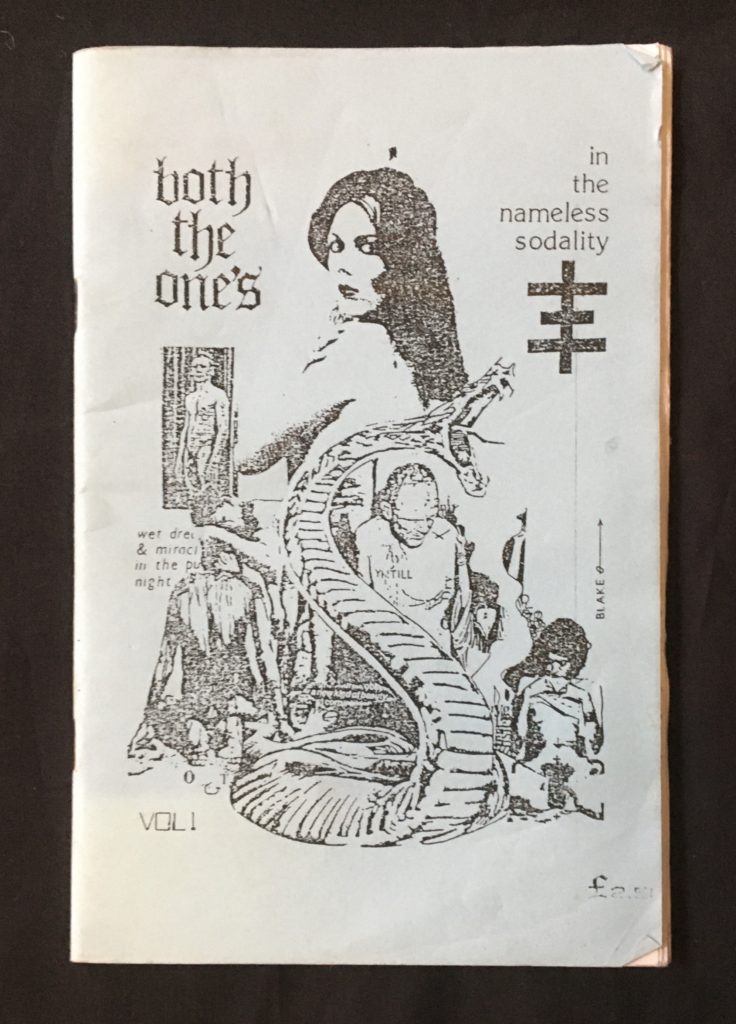
Includes essays and writings from the late Genesis Breyer P-Orridge on vril, sex magic, the Process Church of the Final Judgement, and the Nazi-inspired “Radio Werewolf” movement, as well as a book review of the Anarchist’s Cookbook. P-Orridge, a noted artist and performer, headlined bands Psychic TV and Throbbing Gristle, and maintained tutelary relationships with both William Burroughs and Brion Gysin in their later years. The influence of Gysin’s “dream machine” can be particularly felt in the instructions provided here for empowering a symbol by drawing it over a television screen tuned to a dead channel.
P-Orridge, who identified as one half of an Alchemical Hermaphrodite between two bodies, spent years undergoing surgery to align their body with that of their wife, the late Lady Jaye P-Orridge, who died in Nepal in 2007. The connections to Buddhist philosophy in P-Orridge’s art and thought formed the basis for their solo show “Try to Altar Everything” at New York’s Rubin Museum in 2016.
8vo, 55pp, hand stapled xeroxed pamphlet. Spine creasing and corner folds along front wrap. Creases continue to back. Creasing to top back corner. Past moisture exposure creating warp at lower back corner, with pages warped to match after pg. 23. Good condition.
$375
2. Boullan, Joseph-Antoine. The Admirable Life of The Glorious Patriarch Saint Joseph Taken from the Cite Mystique de Dieu…. New York: D & J Sadlier. 1859.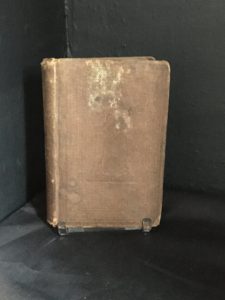 Scarce First English and American edition of one of the only published works by the infamous “satanic” priest, Abbe Joseph-Antoine Boullan. Once a typical Catholic priest in France, when asked to look into the purported visionary states of a local nun, Boullan became convinced. Restyling himself as a John the Baptist like figure, he was excommunicated in 1856, the same year this book was originally written, thanks in part to the pair’s “lascivious” displays. Later, Boullan would clash with the followers of the holy man Vintras, as well as Oswald Wirth and Stanislas de Guita in what has become known as “The War of the Magicians”.
Scarce First English and American edition of one of the only published works by the infamous “satanic” priest, Abbe Joseph-Antoine Boullan. Once a typical Catholic priest in France, when asked to look into the purported visionary states of a local nun, Boullan became convinced. Restyling himself as a John the Baptist like figure, he was excommunicated in 1856, the same year this book was originally written, thanks in part to the pair’s “lascivious” displays. Later, Boullan would clash with the followers of the holy man Vintras, as well as Oswald Wirth and Stanislas de Guita in what has become known as “The War of the Magicians”.
Far more famous for these later exploits, it is likely that the publisher, James Sadlier, had no idea of the controversies embroiling the author back in France when choosing this book for sale to New York’s booming Irish population. The Sadlier family provided so successful in this, they have remained the oldest family owned Catholic publishing company in the country: today’s William H Sadlier, inc.
James Sadlier’s wife, Mary Ann Sadlier, is noted for her contemporary writings on the Irish Diaspora in America, but also served as the translator for nearly all the firm’s French titles, including this one. Her name was not added until the 1873 revised edition.
8vo, 324pp, brown stamped boards with image of St. Joseph. Stain across top of front board and into image. Wear to edges with some fraying at bumped corners. Chipping and losses to top and bottom spine. Bruise to back board edge. Book block scuffed. Floral pastedowns and endpapers. Frontis engraving of the Holy Family. Pages clean. Good condition.
$300
3. BRITTAN, S.B. Ed. The Shekinah. Vol 3. New York. Partridge and Brittan. 1853.
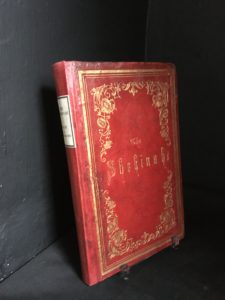
The “first magazine devoted to modern Spiritualism,” The Shekinah, a quarterly, then monthly review “devoted to the Emancipation of Mind, the Elucidation of Vital, Mental, and Spiritual Phenomena, and the Progress of Man” was edited and printed in New York from 1851-1853.
This copy of the third volume belonged to Nathaniel P. Tallmadge (1795-1864), US Senator for New York State (1833-1844) and the 3rd Governor of the Wisconsin Territory.
A noted spiritualist, after converting in 1852, Tallmadge wrote about speaking to the spirits of John C. Calhoun, Henry Clay, and Daniel Webster in journals like The National Intelligencer, The Banner of Light, and The Spiritual Age, as well as the forward and appendix for The Healing of Nations (1855) channeled by the medium Charles Linton. Both the former and this present work were published by Samuel Brittan, Universalist minister turned devotee, editor, and promoter of Andrew Jackson Davis and, later, publisher of The Spiritual Telegraph, arguably the most prominent of the movement’s publications.
Davis, Brittan, and Brittan’s partner, Charles Partridge, exerted enormous sway over the direction of Senator Tallmadge’s public support for spiritualism. In addition to promoting Brittan’s lectures in advertisements (see The Washington Daily Globe, March 21-23, 1854), the most notable incident from this period was the 1854 petition to the US Congress, organized by Tallmadge and read by Brittan, arguing for the reality of Spiritualist phenomena and urging the government to formally investigate such experiences, which met with laughter and derision. Tallmadge remained committed to his beliefs forming the Society for the Diffusion of Spiritual Knowledge in June 1854, the same month and year found in his ownership inscription.
In the address announcing the Society’s creation and intended purpose, Tallmadge said: “We profess to know that angels from heaven—that the spirits of good men progressing toward perfection have come here upon the earth we stand on, and talked with us face to face, and uttered words to us bearing the impress of their divine origin.” These statements appear connected to the annotations found throughout this volume, particularly checkmarks at the appearances of St. Michael in the chapter on Joan of Arc, and also notation on the back pastedown, “Angels, Preuss, 159”, indicating “The Hymn to the Angels” by Charles Preuss.
Considering Tallmadge’s statement in his June 1854 speech that spirits “come here upon the earth” to all those who will “render [their] minds receptive to the truth, and…engage in the investigation”, as well as the references to the angel magic of Dr. John Dee in the speech Tallmadge wrote for James Shields to read before Congress, it is interesting that this is the most worn page in the entire volume. It is also interesting that the essay which immediately follows this hymn is entitled, “Origin and End of Governments”.
8vo. 300pp with pp2 index. Red leather boards inlaid with gilt arabesques. Corners bumped, edges worn with losses. Diagonal scrape to back board. Spine rebacked, bruised, with added title plate. Gilded bookblock edges darkened. Front pastedown and endpapers browned, with binding visible at the gutter. Ownership inscription “N.P. Tallmadge, June 1854.” on front pastedown, with a small red stain to bottom corner. Pages foxed. Small tear to gutter, lower third p 96. Binding worn by extensive reading of pages 159-160. Page 302 misprinted as p 304. Pencil checkmarks, underlines, and annotations. Illustrated with 4 portrait plates, depicting Andrew Jackson Davis, Jacob Behmen, Joan of Arc, and Edwin H. Chopin. Good condition.
$800
4. Cohausen, Johan Heinrich. Goldsmid, Edmund, trans. Hermippus Redivivus: Or, The Sage’s Triumph Over Old Age and The Grave, Wherein, a Method is Laid Down for Prolonging the Life and Vigour of Man. Including a Commentary Upon an Ancient Inscription, in which this Great Secret is Revealed… Privately Printed, Edinburgh. 1885.
An unusual alchemical text based by iatrochemist Johan Heinrich Cohausen on the prolonging of human life by consuming the breath of young women.
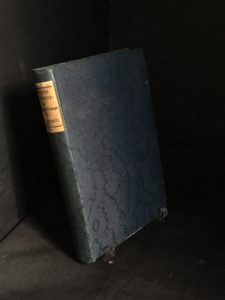
Treated by most as strictly satire , Hermippus Redivivus provides a window into a real vein of biological and medical alchemy that began with
the spagyrics of Paracelsus and was advanced by his student Jan Baptist van Helmont. Comparing the “ingestion” of breath to Sir Robert Boyle’s real pursuit of the supposed Quintessence of Human Blood, Cohausen’s “modest proposal” — related to similar observations regarding prana and the origin of the word “pneuma”– cites the vapour of rebreathed air as the key to longevity, perhaps inspired by Boyle’s own “Suspicions about some hidden qualities of the air” wherein he theorized the atmosphere contained alchemical “volatile salts” (1674)
Although Cohausen is clearly having fun with the topic at hand, his genuine appreciation for alchemy and the work of van Helmont is attested to in his other works, as well as his own career as an iatrochemist. As the translator of this volume, John Campbell, phrased it: “There is in this Dissertation, such a Mixture of serious Irony, as cannot but afford a very agreeable Entertainment to those who are proper Judges of Subjects of this Kind, and who are inclined to see how far the Strength of human Understanding can support philosophical Truths against common Notions, and vulgar Prejudices”
Small 8vo, 162pp, 2 volumes bound together in blue moire cloth boards. Some bruising to edges. Pastedowns and endpapers foxed. Front pastedown with the noted bookplate of David Bixler with his motto “Plus Lis, Moins Sais” , “read more, know less”. Good condition. One of 275 small copies printed for subscribers.
$300
5. Doinel, Jules, et al. [Diploma of Mastery from the Adepts of Isis-Montyon of Orleans]. Paris: Grand Orient de France. 1887.
An unusual piece of French esoterica from the short lived and controversial Masonic lodge redesigned and renamed by famed French gnostic and occultist, Jules Doinel (1827-1902).
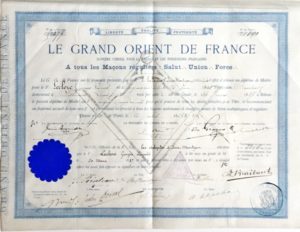 A librarian and archivist by profession, Jules Doinel had been fascinated by the stories of St Joan of Arc and the Cathars from childhood. Following a stint in a Jesuit seminary, his life was split between the two calls: to the priesthood, and to all things esoteric.
A librarian and archivist by profession, Jules Doinel had been fascinated by the stories of St Joan of Arc and the Cathars from childhood. Following a stint in a Jesuit seminary, his life was split between the two calls: to the priesthood, and to all things esoteric.
Accepted into Freemasonry in 1884, by what was then called The Lodge of Emules de Montyon, Doinel quickly rose to mastery and influence, successfully proposing changing the lodge name to include the Egyptian Goddess Isis the following year
To Doinel, the legend of Isis’ devoted search for the pieces of her husband’s body is the perfect symbol for science and the pursuit of hidden knowledge. As he explained in 1886,
“Isis represents the woman, the graceful, powerful and gentle being, through whom the intelligent species continues in this world…it represents for us, in this incessant struggle that we support against all errors and against all prejudices, the search for Truth: Truth dispersed in the Cosmos and in the intelligence, like the parts of the immolated body of Osiris.”
An admitted “hearing and seeing medium” from childhood, Doinel maintained an active interest in Spiritualism as well as the Swedenborg-influenced thought of Louis-Claude de Saint Martin, Martinism, in which he collaborated with Dr. Gerard Encausse, or, Papus. Although the majority of the lodge’s non-Spiritualist members had departed due to his influence, Doinel and his supporters defended that their supposed radicalism aimed to offer true equality in Masonry, opening membership to non-Catholics and non-Christians, anticipating the reforms that further separated French Freemasonry from its “Blue Lodge” counterparts.
Doinel’s separation from other Freemasons began with a series of visions in 1888, building to his self-declaration as “Tau Valentin II”, founding the French Gnostic Church in 1890, claiming to possess the restored secrets of the medieval Cathars.
Doinel’s commitment both to his lodge and his church were tested by Leo Taxil as part of the infamous, anti-Masonic Taxil Hoax. Convinced by Taxil’s story of satanic conspiracies at the heart of Freemasonry, Doinel began to suspect his experiences were a seduction by dark powers. In addition to abandoning his church, in 1895, he wrote Lucifer, Unmasked! under a penname supporting Taxil’s accusations and including purportedly protected Masonic secrets. When Doinel’s authorship was discovered, he was unanimously removed from the Isis-Montyon lodge and Freemasonry, despite having been elected Worshipful Master in both 1893 and 1894. The remaining members then voted to change the name back to “Emules de Montyon”.
Following the exposure of Leo Taxil as a fraud, Doinel attempted to make peace with his old friends to little avail. He died in obscurity at Carcassonne, a key Cathar stronghold, still attending local occult meetings and working as a librarian.
Along with Doinel’s signature in his role as orator, this diploma also bears the signature of multi-term president of the Grand Orient de France, Frederic Desmons, and the noted masonic historian Louis Amiable, author of the famous history of Benjamin Franklin’s Order of the Nine Sisters lodge in 1780s Paris. It is also possible that Georges-Leopold LeClerc may have been a relative of Doinel’s first wife, Stephanie LeClerc
Large, eighths-folded printed diploma, completed by hand in pen. Stamp and seal of the Grand Orient de France, as well as the stamp of the Isis-Montyon Lodge. 11 signatures. Very good with some creases and mild soiling to edges.
$600
6. Byron, Lord George. Fabre D’Olivet, Antoine, trans. Cain, mystère dramatique en trois actes de lord Byron, traduit en vers français et réfuté dans une suite de remarques philosophiques et critiques. Paris: Chez Servier. 1823.
[Personal copy of Papus, Dr. Gerard Encausse.]
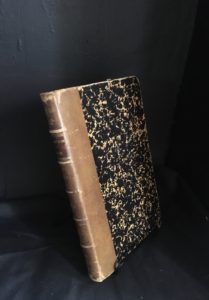 “We can understand one another perfectly; and if I didn’t have anything to reprove you as a heretic, you would not have to fear my orthodoxy.”
“We can understand one another perfectly; and if I didn’t have anything to reprove you as a heretic, you would not have to fear my orthodoxy.”
— Antoine Fabre-D’Olivet to Lord Byron, 1823
Written at the height of Lord Byron’s fame, this “translation” of Lord Byron’s closet drama, Cain, by famed French occultist, linguist, and Martinist mystic Antoine Fabre D’Olivet was intended as both a refutation and attempt at conversion. According to this copy’s former owner, Dr. Gerard Encausse, better known as Papus, author of the Tarot of the Bohemians, spiritual teacher of Tsar Nicholas II, and Fabre-D’Olivet’s eventual heir, it represents, “one of the most beautiful books of scientific morality that we have ever read.”
Addressing the poet as “my Lord” or “mon Adversaire” and writing entirely in French — “evidence of my utmost respect” for Byron’s intelligence—Fabre-D’Olivet explains that he is writing in an effort to save Byron and his readers from a variety of religious errors.
According to Fabre, Byron’s Lucifer, who lures Cain to kill Abel with fine words and argument, misses the hidden symbolism of Genesis in favor of following John Milton.
In his view, the first murder was not a crime, it was a necessary metaphor: Cain, the alchemical fire, destroys Abel, alchemical water, creating alchemical steam, or spirit, for the profligation of humanity.
Chiding Byron as an “Ophite”– after the Gnostic Greek school of Snake worshippers– Fabre cites the Book of Job to say that Satan—Hebrew for “adversary”—is not an independent being but an agent of a higher order. Pulling from sources like Spinoza and Basilius Valentinus, he urges Byron to change his attitudes and perspective on Good, Evil, and Freedom for the sake of himself and others.
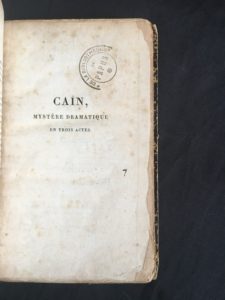
Whether he did not have patience for the long-winded, esoteric critique or because he was fighting in Greece, Byron did not respond. He died the following year.
Given Fabre’s statements about the “fallen” status of the English language, its possible his other ulterior motive for this translation was an attempt to bring it closer to the original divine language he called “Restored Hebrew”.
Dr. Gerard Encausse, in addition to his other work, was an avid book collector, building off the library of his teacher (and Fabre-D’Olivet’s student) Alexandre Saint-Yves, Marquess of Alveydre. This volume, bearing his ex-libris stamp and annotations, likely served as his source when discussing Fabre-D’Olivet’s interpretations of Cain, in his essay on his mentors, “Disciples of the Occult” and in La Cabbale.
Papus’ library was maintained and expanded after his death in 1914 by his son Philippe, whose books are distinguished by the young Encausse’s unique stamp.
According to Philippe’s account, the library was deliberately broken up on August 17, 1942 as Gestapo actions against occult and Masonic groups were focused on the Martinist Order and French Gnostic Church, though he was eventually able to recover some of his father’s papers and collection.
Chez Servier, 1823. 8vo, 248pp + 3pp notes. Contemporary marbled boards with gilt leather spine over original paper wrapper. Backed on loose pages of de Mier Noriega Y Guerra’s Historia de la Revolucion de Neuva Espana (1813). Marbled endpapers, and green ribbon bookmark. Library stamp “Bibliotheque de Papus” on half-title. Back board edge and board corners bumped. Some chipping from shelf wear. Deckled edges, worn, with occasional foxing to pages and one or two small corner tears. Papus’ underlines and notations in black, blue, and red pencil. Good condition. 4 copies listed OCLC as of September 2020, including the collections of Yale, Harvard, and the Bibliothèque Nationale de France.
$5000
7. “Franchezzo”. Farnese, A. A Wanderer in the Spirit Lands. Chicago: The Progressive Thinker Publishing Co. 1901. Second edition.
A purportedly channeled text first published in 1896:
“I do not claim to be its author as I have only acted the part of an amanuensis.” – A. Farnese
 Franchezzo, a sinful and selfish man in life, awakes in a strange dark place only to discover it is his grave. Aware of his former lover weeping at his grave, he alternates between trying to talk to and hold on to her and following a purifying ascent through the levels of the afterlife led on by his spirit guides, anticipating popular spectral romance tropes.
Franchezzo, a sinful and selfish man in life, awakes in a strange dark place only to discover it is his grave. Aware of his former lover weeping at his grave, he alternates between trying to talk to and hold on to her and following a purifying ascent through the levels of the afterlife led on by his spirit guides, anticipating popular spectral romance tropes.
An excellent example of the Progressive Thinker company’s characteristic offerings, this book was one of many influential publications put out by the Chicago publishing house and Spiritualist newspaper, providing perspective on the state of Spiritualist thought and media at the turn of the century.
8vo, stamped green cloth boards with decorative title. Shelf-cocked. Some small scratches to front board, and wear to back board edges. Pages darkened but clean. Good condition.
$250
8. Geoffrois, Patrick. Excerpts from Incantations of a Magickal Warrior, Vol. 1. Electric Press. New York. 1987.
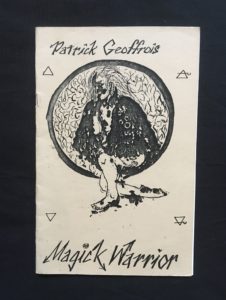 Patrick Geoffrois (1950-1994) one of Paris’ “electric poets”, a radical 1960s poetry movement inspired in equal parts by dada, surrealism, and the Beats. With collaborator Michel Bulteau, he founded the psychedelic rock band Mahogany Brain, before abandoning everything to seek spirituality in India.
Patrick Geoffrois (1950-1994) one of Paris’ “electric poets”, a radical 1960s poetry movement inspired in equal parts by dada, surrealism, and the Beats. With collaborator Michel Bulteau, he founded the psychedelic rock band Mahogany Brain, before abandoning everything to seek spirituality in India.
Geoffrois met A.C. Bhaktivedanta Swami Prabhupada, the founder of “The Hare Krishna Movement”, and quickly became a devotee, distributing the group’s literature throughout Europe and eventually New York City. Following Prabhupada’s death in 1977, Geoffrois gave up on the movement. In addition to playing guitar for James Chance and the Contortions, Geoffrois was a tarot card and palm reader and heroin dealer on Saint Marks Place.
During the 1989-1990 New York police investigation into the murder of swiss dancer Monkia Beerle by her boyfriend Daniel Rakowitz, “The Butcher of Tompkins Square Park”, Geoffrois’ reputation as a “black magician”, “satanist”, and “anarchist necromancer” put him at the center of an elaborate (baseless) conspiracy theory characteristic of other Satanic Panic incidents, leading Newsday to call him the “Lucifer of the Lower East Side”.
Since his death from AIDS in 1994, Geoffrois lives on as a near-legendary figure in books like Jarrett Kobeck’s The Future Won’t Be Long (2017) and in the film Downtown 81, which was later dedicated to his memory along with the late Jean-Michel Basquiat.
A perfect encapsulation of its mysterious and multifaceted author, this hand-stapled zine is hard to succinctly describe. Part book of poetry, part book of spells, it is the expression of Geoffrois’ personal philosophy and credo as a “Magickal Warrior”.
12mo. 16pp. Good condition, some slight creasing to the spine. Pages clean. Several small stains on back wrapper. First edition. One of 100 copies.
$275
9. Grant, Kenneth. Cults Of The Shadow. Samuel Weiser Inc. New York. 1976.
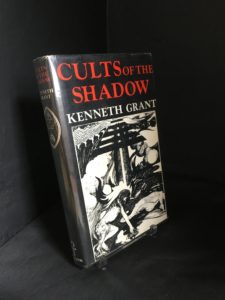 The First American edition of Kenneth Grant’s iconic exploration of dark magic, this text includes examinations of both his mentors, Aleister Crowley and Austin Osman Spare, and Chicago’s secretive Cult of the Black Serpent led by gnostic voodoo priest Michael Bertiaux
The First American edition of Kenneth Grant’s iconic exploration of dark magic, this text includes examinations of both his mentors, Aleister Crowley and Austin Osman Spare, and Chicago’s secretive Cult of the Black Serpent led by gnostic voodoo priest Michael Bertiaux
Relentlessly exploratory and experimental Kenneth Grant, Crowley’s personal secretary in the last years of his life and a friend and patron to Austin Osman Spare in his old age, expelled from Crowley’s para-masonic magical organization, the Ordo Templi Orientis, by its second leader Karl Germer for incorporating elements of Tantra and the work of HP Lovecraft into practices the order considers sacred.
Following Germer’s death, Grant declared himself the new head of the OTO in 1969 only to have his claims disputed and ignored by the group’s new leadership. Founding his own group, the Typhonian OTO, Grant went on to an illustrious career in occult circles, particularly noted for this two Typhonian book trilogies, of which this volume marks the end of the first. Cults of the Shadow is particularly noted for being one of the most in depth sources on the beliefs and practices of Michael Bertiaux’s Gnostic Voudon movement, which was limited to internal course material prior to the publication of the Voudon Gnostic Workbook.
Grant died in 2011, followed in 2019 by his wife and collaborator Steffi Grant, a noted artist and thinker in her own right. In addition to introducing her husband to Austin Osman Spare, Steffi Grant contributed artwork for all his books including this one’s frontispiece and dust jacket cover, “Lycanthropy”.
8vo. pp208 + glossary and index. Black cloth boards with title, publisher, author and OTO seal gilt in silver on spine. Two small scuffs to front board. Bookblock lightly spotted, endpapers and pastedowns darkened. Pages clean and legible. Very good condition. Dust jacket clean with wear to top and bottom edges. Top and bottom spine and fore corners worn, small tear along top spine near joints. Discoloration to interior. Very good condition. 22 illustrations.
$160
10. [Hebborn, Eric]. [Forged Austin Osman Spare Bookplate Study]. C. 1986-1996.
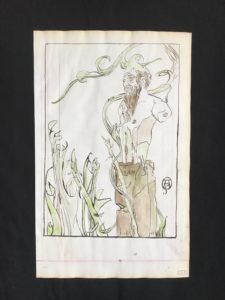 Eric Hebborn (1939-1996), one of the most successful art forgers of the 20th century, is known for his recreations of Flemish Old Master Drawings as well as “studies” from Italian luminaries like Michelangelo, Raphael, and DaVinci. His work is known to have found its way into the Morgan Library and the National Gallery of Art.
Eric Hebborn (1939-1996), one of the most successful art forgers of the 20th century, is known for his recreations of Flemish Old Master Drawings as well as “studies” from Italian luminaries like Michelangelo, Raphael, and DaVinci. His work is known to have found its way into the Morgan Library and the National Gallery of Art.
Controversially, though he also claimed he created several pieces at the MET and the J. Paul Getty Museum to the protests of both institutions.
Admitting in a 1994 BBC interview that he had on occasion copied modern masters, it appears Hebborn was aware of and following the increasing value of artwork by British occultist, author, painter, and engraver Austin Osman Spare (1886-1956). An associate of Aleister Crowley and Kenneth Grant, credited by some with starting the “chaos magic” movement of the 20th century, Spare saw fame as a draftsman and portrait artist in the 1910s before spending several decades more focused on mysticism than art.
Largely forgotten after death, Spare’s first modern gallery shows and auctions began in 1986 following renewed interest in his work spurred by Kenneth Grant and the republication of several of Spare’s most famous works in a new edition of A Book of Automatic Drawings by Catalpa Press in 1973.
An excellent copy of Spare’s noted 1922 bookplate for the collector Pickford Waller featuring a prominent image of the god Pan, reprinted in The Golden Hind, Hebborn’s craft is excellent but betrayed by several details. In addition to lingering line rules remaining after chemical treatment, the paper is identical to another signed Hebborn drawing currently in the Ellipsis collection and matched by watermark. Unfortunately for a forger Eric Hebborn was colorblind, occasionally confusing subtle grays and bright greens, and “ruining” drawings. It is presumed this was one such “ruined” forgery, conducted prior to his death in 1996.
Found beaten to death on the street in Rome, rumors persist that he worked for the Mafia, who may have taken issue with his then-newly released tell-all, republished in English the next year as The Art Forger’s Handbook.
Rome, c. 1986-1996. Large A4, gouache and ink drawing, expertly executed, on a treated leaf taken from a ledger of the Equitable Gas Company. Sheet warped from forger’s chemical treatment, light discolorations along edges. Good condition. Ellipsis Rare Books, Certificate of Inauthenticity included.
$2500
11. Howard, Maude. Myriam and the Mystic Brotherhood. Chicago: Occult Publishing Company, 1915.
Second Edition of the scarce original initiatory novel about a secret society of Ascended Masters.
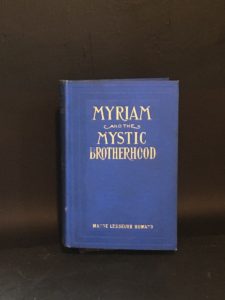 Similar to the earlier The Coming Race or certain interpretations of Theosophy, Myriam and the Mystic Brotherhood depicts the take over of the modern (1910s) United States by a mysterious order of Ascended Masters.
Similar to the earlier The Coming Race or certain interpretations of Theosophy, Myriam and the Mystic Brotherhood depicts the take over of the modern (1910s) United States by a mysterious order of Ascended Masters.
Told from the perspective of the two St. Clair siblings, Harold and Myriam, who encounter an order of alchemical monks living in underground caves in the American West before becoming initiates into their secret mystery traditions. In addition to providing mankind with untapped mystical knowledge, they also present new technology, combining science-fiction, occult fantasy, and utopian literature, as they guide humanity into a new material and spiritual golden age.
Arguably groundbreaking in several other respects, this book has the dubious distinction of serving as one of the major “sources” for “I AM” founder Guy Ballard’s largely plagiarized memoir The Magic Presence.
A Theosophist and self-described mystic, Ballard’s I AM Activity movement grew to enormous popularity in the 1930s and 1940s, centering on the teachings of ascended masters like Jesus Christ, the Comte de Saint-Germain, and, supposedly, both Ballard and his wife Edna after their deaths.
According to Ballard’s book, he met with 200 members of a “Great White Brotherhood”, operating a blast furnace in a cave of symbols before being initiated by the Comte de Saint Germain. The scene describing Ballard’s initiation ceremony with the Ascended Masters is literally taken word for word from this novel, something noticed by critics as early as 1937.
An ex-library copy, this was formerly owned by the Blue Triangle Hospitality House charity in Burlington, Vermont, which provided lodging and meals for independent young women. Originally a private home, by the outbreak of World War I, the Hospitality House was Burlington’s first “day nursery”, then the “Patriotic League” in 1917 organizing young women for the war effort, and finally a transition home for newly arrived French “war brides” before becoming the Blue Triangle Hospitality House. Opened in December 1919, the organization was absorbed into the Young Women’s Christian Association in 1921.
8vo, 370pp, blue stamped boards with title and author in embossed in white on front board and spine. Some wear at corners and edges. Spine darkened and bumped. Small ink stain to back board. Light soiling to bookblock edges. Stamp of the Blue Triangle Hospitality House on front paste down and first free endpaper. Pages clean apart from 4 page ¼” stain across upper margins. Page 223 with two small holes in margin suggestive of stapling. Very good condition.
$250
12. Inman, Thomas. On Ancient Pillar Stones and Cairns. Liverpool: Adam Holden, 1867.
First Edition of a beautifully illustrated lecture on megaliths and stone circles.
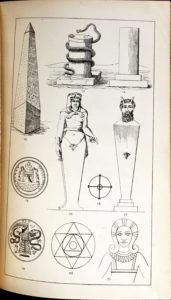 Although Thomas Inman (1820-1876) worked for years as the house physician and surgeon at the Liverpool Royal Infirmary, his real passion was as president of the Liverpool Literary and Philosophical Society. Inman made many presentations on his research and theories, expounding on the pagan influences on early Christianity and the hidden meanings found in symbols still used to the present day.
Although Thomas Inman (1820-1876) worked for years as the house physician and surgeon at the Liverpool Royal Infirmary, his real passion was as president of the Liverpool Literary and Philosophical Society. Inman made many presentations on his research and theories, expounding on the pagan influences on early Christianity and the hidden meanings found in symbols still used to the present day.
This short illustrated treatise, originally presented as a lecture to the society, provides an overview and analysis of the worship of standing stones, cairns, and stone circles in the British Isles and around the globe highlighting parallels between practices from Babylon, Ancient Greece, the Hebrew Bible, and India.
Characteristic of Inman’s fixation on phallus worship as the origin of religion, the text describes various pillars, pyramids, standing stones, columns, and cones found in temples, texts, carvings, and worship sites, as stand-ins for deities, delineators of space, and memorials to past people and events. Complete with five plates of marvelous illustrations.
12mo. 32pp. Minor rubbing to edges and spine with wear more significant at top fore edge of front board. Slight discoloration to boards near edges, more significant on the front than back. Ink handwriting from former owner and some staining on original, blue, wrap. Title page clean save one or two small superficial stains and the embossed library stamp of former owner, author and dentist D.V. Beacock. Pages warped, clean apart from small pen and pencil annotations. Five black and white illustration plates with descriptions, 2pp typewritten notes. Good condition.
$150
13. Kaiser, Leslie Ming.[Pseudonym: Fisher, Dorothea] Love’s Master Stroke. London: Regency Press. 1969. First Edition.
A strange “romance novel” purportedly based on the author’s real experiences of spiritual and sexual awakening through esoteric initiation.
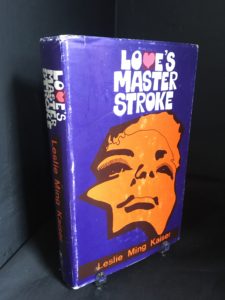 Dedicated to the mysterious Comte de St. Germain “the wonderman of Europe”, possible author of the Most Holy Trinosophia, who is rumored to be an immortal ascended master (although he officially died in 1784), the narrative breaks off into essays on Francis Bacon’s Nova Organum, the secret life of Jesus, and St. Germain’s continued life as an alchemist who instructs the protagonists.
Dedicated to the mysterious Comte de St. Germain “the wonderman of Europe”, possible author of the Most Holy Trinosophia, who is rumored to be an immortal ascended master (although he officially died in 1784), the narrative breaks off into essays on Francis Bacon’s Nova Organum, the secret life of Jesus, and St. Germain’s continued life as an alchemist who instructs the protagonists.
8vo, 600pp, blue cloth boards. Glossy pages, clean with some yellowing to edges. Very good condition. Purple pictorial dust jacket with some wear and color losses, small chipping at edges. Good condition.
$100
14. Maynard, Nettie. Was Abraham Lincoln a Spiritualist? Or, Curious Revelations From The Life of a Trance Medium. Philadelphia: Rufus C. Hartranft, 1891. First Edition.
First edition of famous account of seances in the Lincoln White House.
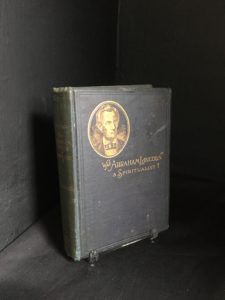 This purported first hand account by medium Nettie Maynard, a genuine-if-controversial associate of Mary Todd Lincoln, maybe the most detailed account of a strange period of American History.
This purported first hand account by medium Nettie Maynard, a genuine-if-controversial associate of Mary Todd Lincoln, maybe the most detailed account of a strange period of American History.
Following the death of their son William Lincoln in 1862, Mrs. Lincoln experimented with Spiritualism, conducting at least eight sessions in the Red Room of the White House, according to the White House Historical Association. While both President Lincoln and Ms. Maynard may have been present for these sessions (Maynard calls it here the “Red Parlour”) her recollection thirty years later places her at the center of Civil War politics. Perhaps most striking, Maynard claims to have predicted and encouraged Lincoln to sign the Emancipation Proclamation, telling him to “fearlessly perform the work and full the mission for which he had been raised up by an overruling Providence.” Maynard died the year following its publication.
The former copy of Elizur Parsons, noted Connecticut Spiritualist, listed among those present at the New England Spiritualist Camp Meeting Association of Lake Pleasant, Mass in 1878 and as the representative for the Connecticut Spiritualist Association at the 1905 national convention. Maynard, also from Connecticut, appears to have been an acquaintance of Parsons. In multiple places throughout the text, Parsons corrects the spelling of place names and provides updates on the whereabouts of various individuals.
8vo, 264pp, blue cloth boards with title and Lincoln portrait gilt stamped to front. Title and author repeated on spine. Small stains and scuffing to boards, back sun faded, with small bump to top back board edge. Corners bumped. Book block darkened. Some foxing, and pencil corrections by the former owner. Ownership signature and borrowing instructions written in pencil on first free endpaper. Good condition.
$600
15. McKeever, Edwin. Prenatal Astrology. San Francisco, CA : Privately Printed. 1926.
Scarce 1920s Astrological Zine w/ Analyses of Famous Scientists and Air Disaster
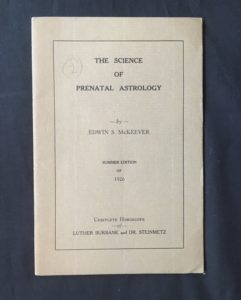 The second of seven issues from the scarce self-published quarterly journal of a San Francisco astrologer.
The second of seven issues from the scarce self-published quarterly journal of a San Francisco astrologer.
Here, McKeever attempts to establish the principle of astrological influence by examining menstruation, sex, and childbirth as well as the natal charts of two late scientists and the timing of a famous air disaster.
In addition to analyzing the charts of Botanist Luther Burbank and alternating current proponent Dr. Charles Steinmetz, McKeever includes a comparison chart for an averted air disaster six weeks before the September 1925 crash of the USS Shenandoah, one of four rigid airships built for use by the US Navy.
Several pages of advertising included at the end showing the still extant Llewellyn Publishing’s early, entirely astrological offerings.
8vo, staple bound typewritten pamphlet. Bookseller’s pencil on front wrap, corners bent. Astrological table printed to interior of back wrap. Some creasing to spine. Good condition.
$150
16. Ptolemy. Ashmand, JM, Trans. Ptolemy’s Tetrabiblos Or Quadripartite Being Four Books Of The Influence Of The Stars Newly Translated From The Greek Paraphrase Of Proclus…. London: Davis And Dickson, 1822.
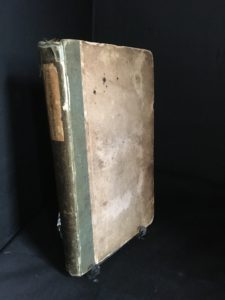 A well loved, unique copy of the most popular ancient text on astrology, this 1822 edition of the 2nd Century text, translated by J.M. Ashmand from the 1630 Latin translation by Vatican scholar Leo Allatius. One of the first widely available English versions, serving as a cornerstone for the 19th and 20th-century astrology revival, this copy is especially interesting due to its additional details. Throughout the text, the unknown owner has made every correction provided by the editors in pencil and written a note on the front pastedown titled “Cameleons Cohabiled Sept. 7, 1876 btween 11 and 12/ Noon”. Below, the owner has calculated out the “time lords” or ruling planets of the years of a person’s life, supplying both the duration of rulership, and a person’s approximate ages, explained in Book 4 Chapter 10 of the present text, the source of the seven ages of man described by Shakespeare in As You Like It’s “All the World Is a Stage” speech. In addition, this copy has the bookseller’s label on the back pastedown of Ralph Kraum, author of Astrological Americana.
A well loved, unique copy of the most popular ancient text on astrology, this 1822 edition of the 2nd Century text, translated by J.M. Ashmand from the 1630 Latin translation by Vatican scholar Leo Allatius. One of the first widely available English versions, serving as a cornerstone for the 19th and 20th-century astrology revival, this copy is especially interesting due to its additional details. Throughout the text, the unknown owner has made every correction provided by the editors in pencil and written a note on the front pastedown titled “Cameleons Cohabiled Sept. 7, 1876 btween 11 and 12/ Noon”. Below, the owner has calculated out the “time lords” or ruling planets of the years of a person’s life, supplying both the duration of rulership, and a person’s approximate ages, explained in Book 4 Chapter 10 of the present text, the source of the seven ages of man described by Shakespeare in As You Like It’s “All the World Is a Stage” speech. In addition, this copy has the bookseller’s label on the back pastedown of Ralph Kraum, author of Astrological Americana.
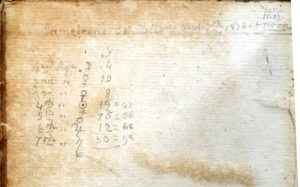
8vo. pp. 2 p.l., xxvii, [1]ads, 240. lithographed frontis. Appendix diagram included. Original cloth-backed boards intact though quite worn: chipping, bumping, fraying along the fore-edges, with evidence of ink drop stains to the front board. Blue paper underlay beginning to show along backboard. Top most portion of the spine frayed and partially split. Significant foxing to front and back pastedowns and free endpapers as well as the title page. Chip missing from the front free endpaper. Text otherwise quite clean, though it shows superficial warping. Binding quite solid. Small booksellers sticker on back pastedown near spine. Front pastedown includes a small section of penciled notes for astrological calculations dated September 7, 1876.
$150
17. [Rivé, Jean-Joseph. Suspected.] [Partial Abognazar King of Solomon Manuscript Grimoire, Copied from BNF MS 25314.] France. c. 1781-4.
A partial original manuscript copy of the Key of Solomon grimoire written by an unknown scribe, suspected to be Abbé Jean-Joseph Rivé (1730-1791), noted bibliographer and librarian. Provenance: estate of Russell Johanson (1941 – 2013), owner of Ravenna Rare Books, Seattle.
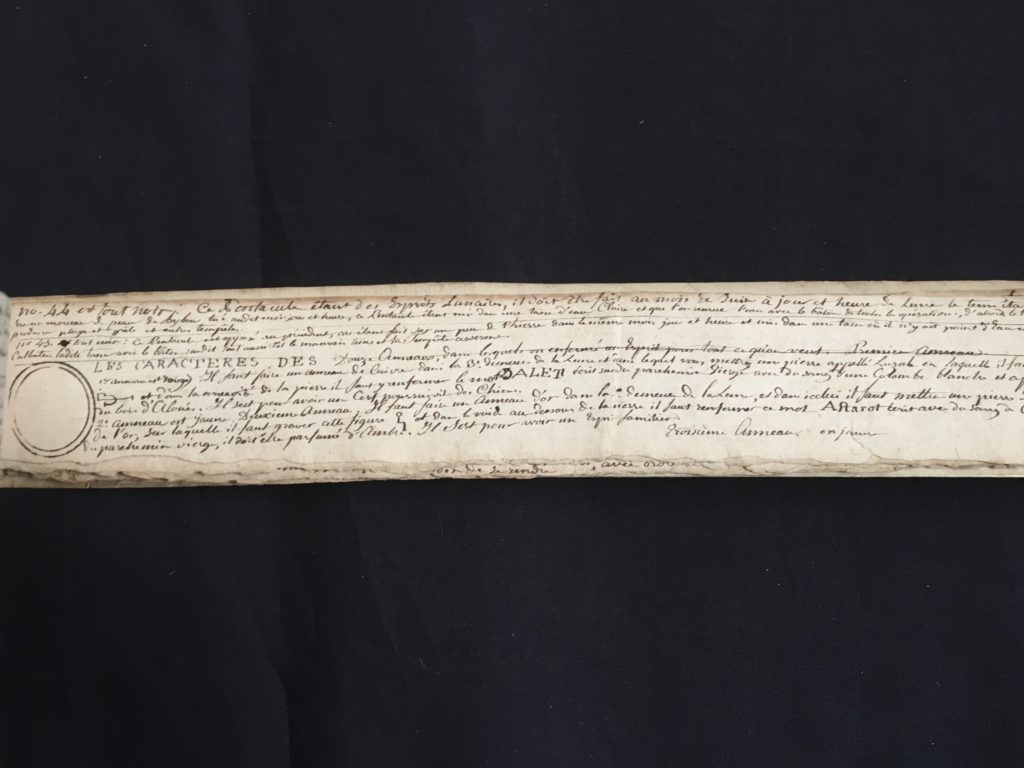
What is typically called “The Key of Solomon” today is a text edited together from three French examples favored by Golden Dawn founder S.L. MacGregor Mathers. However, “The Key of Solomon” has never been one unified text. Dr. Stephen Skinner’s survey of European and American library holdings arrived at 10 distinct Key “families” made up of 144 unique original grimoire manuscripts.
Since the first Key manuscripts appeared in Greek in the 14th century they have been evolving in transmission. An individual in the pre-Modern period might only encounter a grimoire once, they would copy what they could down for personal use, resulting in errors, deviations, and additions with each new manuscript, depending on the author’s accuracy, taste, or personal trial-and-error. It is thought that this original process of scribes passing and collecting from grimoire to grimoire may have organically inspired the wide variety of magical literature that reached mass publication in the 19th century.
This previously unstudied example is one of the rarer “Abognazar family” Keys originating from Arles of which the British Library’s Lansdowne MS 1203 is the most famous example. Unusual for its size, dimensions, and near complete lack of illustrations — the almost universal Solomonic pentacles are described, not shown— the text’s content consists of the final third of the “usual” Abognazar structure, explaining how to make a magic carpet, create various rings (sometimes called the “Necromantic Rings of Solomon” in other texts), and control demonic spirits.
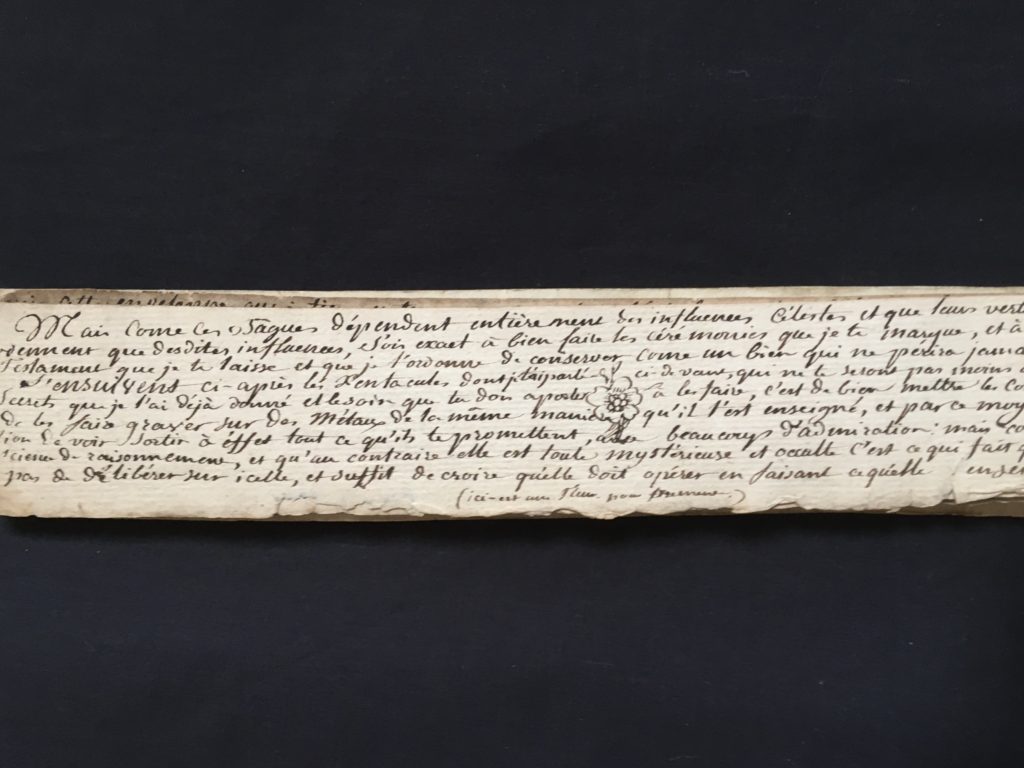
Despite its Spartan design, the manuscript is textually identical to and contains details and references to the unique visual features of one of the most luxurious Key of Solomon manuscripts. An out of place flower illumination in the middle of an unrelated paragraph, with a parenthetical note about its placement, directly connects this manuscript to the Bibliotheque Nationale’s MS BN 25314, specially created for the noted bibliophile Louis César de La Baume Le Blanc, the Duc de la Vallière by F. F. Fyot in 1781 (ante dated 1634), and sold at auction to the Bibliotheque Royale– which became the Bibliotheque Nationale– at the time of his death in 1784 (Dorbonne-Aine, 771; Catalogue des livres de la bibliothèque de feu m.le duc de la Vallière, Vol 1).
A contemporary addendum not found in the original suggests its creation predates the 1784 sale. After copying the final lines, the scribe has included nearly two pages of spirit lists of the angels and demons of the hours and days of the week, copied from the 1416 first French edition of Cornelius Aggipa’s De Philosophie Occulte. The 1784 catalogue of the La Valliere auction reveals a copy of the same edition of Agrippa was sold alongside his key, but does not appear in the holdings of the Bibliotheque Nationale. Based on these facts, it is likely this manuscript was transcribed from the Duc De La Valliere’s grimoire, within his library, by someone with the access and solitude to copy both books, and the economic status to afford the vellum to make this manuscript but not commission their own fine edition. (One possible explanation for this example’s unique design is that it was meant to slip quickly and discreetly up a sleeve for easy hiding in case of interruption).
In searching for the suspected scribe, few candidates are clearer than La Valliere’s librarian, Abbe Jean-Joseph Rivé. A noted bibliographer, as well as the man most responsible for creating what has been called the greatest library of its age, Rivé’s esoteric interests are attested to by the catalogue from the sale of his book collection at Marseilles in 1793. Attempts at handwriting comparison have been hindered by COVID-19 closure of relevant archives as of September 2020.
12in x 2in. 32pp. Limp leather with stitch binding. Boards warped. Deckled edges and some small tears. Final page repaired with document tape. Some small illustrations and pseudo-Hebrew throughout. Good condition.
18. Summers, Montague. The Geography of Witchcraft. New York: Alfred A. Knopf, 1927.
First American edition of Montague Summers seminal history of Witchcraft.
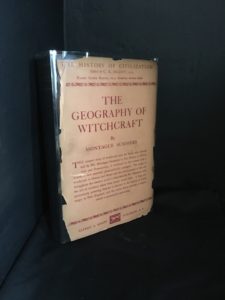 Written by controversial 20th-century scholar Montague Summers, The Geography of Witchcraft served as the second in his original trilogy of books on the subject, following 1926’s The History of Witchcraft and Demonology ahead of Summer’s famous 1928 English translation of the Malleus Maleficarum witch hunting manual, The Hammer of the Witches. A very literal title, this text provides a breakdown by country and region of notable Witchcraft cases and trials, identifying the commonalities and differences across cultures.
Written by controversial 20th-century scholar Montague Summers, The Geography of Witchcraft served as the second in his original trilogy of books on the subject, following 1926’s The History of Witchcraft and Demonology ahead of Summer’s famous 1928 English translation of the Malleus Maleficarum witch hunting manual, The Hammer of the Witches. A very literal title, this text provides a breakdown by country and region of notable Witchcraft cases and trials, identifying the commonalities and differences across cultures.
After graduating from Oxford and being ordained as a Anglican deacon in 1907, Summers converted to Catholicism, styling himself as “The Reverend Alphonsus Joseph-Mary Augustus Montague Summers”, though no evidence exists of his formal ordination.
Dogged throughout his life accusations of pederasty (for which he was charged and acquitted) as well as Satanism, for which he was not, Summers’ works drip a kind of fanatical obsession they don’t make anymore
One of only 1040 copies, few known examples with even a fragment dustjacket.
8vo, 623pp + 4ads, original black cloth boards. Very fine condition. Spine intact, cosmetic breaks in three places. Some rubbing along edges, front board corners slightly bent and frayed. Partial dust jacket. Black and White engravings throughout.
19. [Swedenborg, Emmanuel]. De telluribus in mundo nostro solari, quæ vocantur planetæ: et de telluribus in coelo astrifero. London: [John Lewis]. 1758.
“By the Lord’s divine mercy the deeper levels within me, which belong to my spirit, have been opened, enabling me to talk with spirits and angels—not only those near our world, but also those close to other planets.”
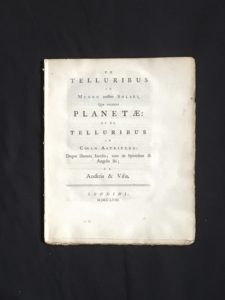 The first edition of one of the first mystical works of Swedish scientist, diplomat, and religious leader Emmanuel Swedenborg, recording his visionary experiences exploring the solar system and his communications with the various angels and demons he claimed to have encountered among the planets and moons of our solar system.
The first edition of one of the first mystical works of Swedish scientist, diplomat, and religious leader Emmanuel Swedenborg, recording his visionary experiences exploring the solar system and his communications with the various angels and demons he claimed to have encountered among the planets and moons of our solar system.
Swedenborg, regarded as a prophet by the “New Church”, preached that the apocalypse was spiritual and had already happened in 1754. His emphasis on hypnogogic visions and unseen entities shares many overlaps with the later Spiritualist movement.
Famous in his own time for his earlier, more traditional writings, it is interesting to note that neither he, nor the publisher, John Lewis, placed their name on the final title page, and less than 1000 copies were printed. This appears to have been Lewis and Swedenborg’s arrangement for several of his early works in this period.
4to, 72pp, unbound stitched sheets, distorted by press. Occasional foxing, otherwise quite clean. Deckled edges with less than expected wear. Small worming to recto, penetrating a few pages. Very good.
$650
20. Thomas, Franklin. How to Hold Circles. Boston: Machine Printing Co. 1920. Second edition.
A New Thought inspired guide to practical spiritualism written by Omaha-based clairvoyant, Franklin Alonzo Thomas, writer and creator of “Soul Science”.
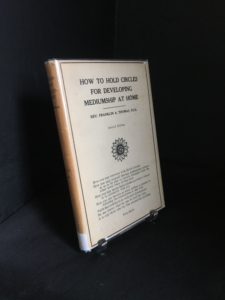 A short but deliberately structured sequence of development exercises for spiritualist mediumship, Thomas describes the practice of opening communications with the spirit world and the importance of maintaining focused concentration and good intentions. In addition to describing spirit vision and how to gain it, Thomas talks about spirit guides and theorizes on how different groups of people experience the afterlife as well as supplying some of his original poetry.
A short but deliberately structured sequence of development exercises for spiritualist mediumship, Thomas describes the practice of opening communications with the spirit world and the importance of maintaining focused concentration and good intentions. In addition to describing spirit vision and how to gain it, Thomas talks about spirit guides and theorizes on how different groups of people experience the afterlife as well as supplying some of his original poetry.
Thomas would later claim to have been the victim of an NYPD sting operation with an undercover officer posing as a potential patient while on a visit to his sister.
12mo, 87pp, clipped dust jacket, chipping at corners and missing ½” at bottom spine. Small tear to margin of page 12. Very good condition.
$250
21. [Thornely, Kerry]. Malacalypse the Younger. Omar Khayyam Ravenhurst. Robert Anton Wilson. Principia Discordia or How I Found Goddess and What I Did To Her When I Found Her. Loompanics Unlimited. Mason, Michigan. C. 1980.
The classic and iconic Loompanics edition of the foundational Discordian “religious” text, the Principia Discordia, first to feature the fabulous spiral cover design and the celebrated introductory essay by Robert Anton Wilson.
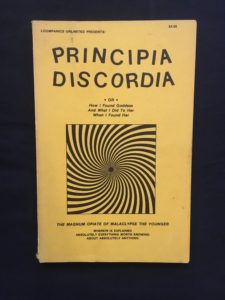 A surreal spiritual text that starts with a classic opening (two intoxicated men meeting the Goddess of Chaos, Eris, in a bowling alley) the journey of the Principia Discordia through editions is more than a little unusual. The “magnum opiate” first appeared in the form of 5 hand xeroxed and stapled copies produced out of Kerry Wendell Thornley’s home before expanding out to 500 copies by his third edition in 1976. Eventually Thornley outsourced the process to Loompanics Unlimited who released their white first edition (and the overall fourth edition) in 1978. In addition to its new cover and Wilson’s introduction, the updated 1980 edition greatly expands the text with several sections of new material including the so-called “Fifth Edition” section, an interview and original collage artwork from Greg Hill.
A surreal spiritual text that starts with a classic opening (two intoxicated men meeting the Goddess of Chaos, Eris, in a bowling alley) the journey of the Principia Discordia through editions is more than a little unusual. The “magnum opiate” first appeared in the form of 5 hand xeroxed and stapled copies produced out of Kerry Wendell Thornley’s home before expanding out to 500 copies by his third edition in 1976. Eventually Thornley outsourced the process to Loompanics Unlimited who released their white first edition (and the overall fourth edition) in 1978. In addition to its new cover and Wilson’s introduction, the updated 1980 edition greatly expands the text with several sections of new material including the so-called “Fifth Edition” section, an interview and original collage artwork from Greg Hill.
8vo, pp74 + [3] + 10 + [3] + 1 ad. A well-loved copy with light soiling and wear to wraps, small tear and peeling to bottom spine, and occasional interior spotting. Good condition.
$90
22. Turner, Robert, Trans. The Notary Art of Solomon. Seattle: Trident Books. 1987. First Trident Books Edition.
Scarce first Trident edition of the Notary Art of Solomon, reprinting the 1657 English translation by Robert Turner.
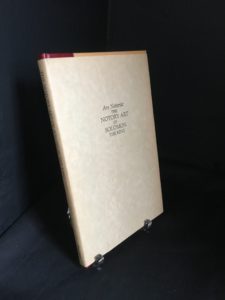 The Ars Notoria, one of several grimoires typically included in the Lemegeton along with the more famous Ars Goetia, is an unusual magical text first seen in the 13th century. Passed around between monks at the universities of Paris, Toledo, and elsewhere, the prayers, meditations, and invocations contained in the work are supposed to improve the practitioner’s memory and teach mastery of theology, the liberal arts, mathematics, and other subjects.
The Ars Notoria, one of several grimoires typically included in the Lemegeton along with the more famous Ars Goetia, is an unusual magical text first seen in the 13th century. Passed around between monks at the universities of Paris, Toledo, and elsewhere, the prayers, meditations, and invocations contained in the work are supposed to improve the practitioner’s memory and teach mastery of theology, the liberal arts, mathematics, and other subjects.
It was the forbidden “student’s helper”, like modern study drugs, of the medieval scholar.
8vo, 76pp, tan cloth boards with title in red. Maroon leatherette spine. Small scratch to back board. Pages clean, binding tight. In original dust jacket. Near Fine.
$350
23. Vadier, [Marc-Guillaume Alexis]. Rapport et Projet De Décret, Présentés A La Convention Nationale, au nom des comités de sûreté générale et de salut public, Par Vader, Séance du 27 prairial, l’an deuxième de la République française une et indivisible. National Printer. Paris. June 1794.
Original French Revolutionary Report on Cult Activities Responsible for The Fall of Robespierre
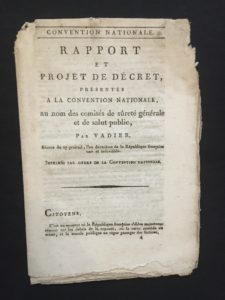 This report by National Convention member Marc-Guillaume Vadier, was one of several documents that signed the death sentence for Maximilien Robespierre, ushering in his overthrow and execution.
This report by National Convention member Marc-Guillaume Vadier, was one of several documents that signed the death sentence for Maximilien Robespierre, ushering in his overthrow and execution.
Written at the height of the Terror, not long after the imposition of Robespierre’s national “Cult of the Supreme Being”, this text claims to be an accurate representation of Vadier’s observations during an undercover investigation of the group remembered as the “Theotist Cult”. According to Vadier, the 80-year-old visionary Catherine Théot claimed to be the “New Eve” and a second Mary who would give birth to the new Christ of Revelations.
Scholars suggest that Vadier fabricated his accusations for political expediency,but the details he describes are suspiciously coherent. In addition to recording a blessing involving seven kisses, and prayers like, “No cult, no priests, no king, but you, the New Eve”, Vadier provides a detailed list of various items in their possession including occult and pre – Spiritualist books and grimoires like the Key of Solomon and the Enchiridion of Pope Leo grimoires, the Prophecies of Nostradamus, four handwritten notebooks of Kabbalistic prayers, as well as a paper talisman covered in angelic names.
Shortly after this report’s publication, Vadier claimed to find letters between Théot and Robespierre telling the politician he was the new John the Baptist, washing away the old world with blood. This led to his arrest and execution as well as Theot’s death in prison.
8vo. Unbound pamphlet. pp16, some uncut. Chipping and losses along top edge corners. Pages uneven and text faded in places. Wear to exposed page ends. Good condition.
$175
24. Walton, Frederick. The Infancy and Development of Linoleum Floorcloth. London: Simpton, Marshall, Hamilton, Kent & Co. Undated. First English Edition.
Linoleum- A Psychic’s Suggestion?

An unusual book about a ubiquitous modern material, this book on Linoleum written by its inventor, Frederick Walton, explains the trials and steps taken to develop the artificial flooring.
In the last chapter “A Visit to a Clairvoyant…” Walton asserts that a psychic healer told him of his future successes and described his inlay machine 30 years before he invented it.
This first edition of the scarce work was rebound and distributed by the Armstrong Cork Company’s Linoleum division for the 9th Convention of Armstrong Jobbers, numbered and signed by Walton on its bookplate.
12mo, 56pp, contemporary rebinding, black papered boards with red treated cloth spine. Small puncture to front board below title plate. Minor scuffing to back board with bruise to back front edge. Signed photograph plate of author pasted on front pastedown, provided by the Armstrong Cork Company, numbered “Book 101”. Faint stain margin of page 32 – 33, otherwise clean but aged. Very good condition.
$100
25. Warne, George. A Lecture On Spiritualism Delivered At Oklahoma City, OK September 9, 1920. Oklahoma City: Oklahoma State Spiritualist Association.
Original Spiritualist lecture pamphlet from Dr. George B. Warne, President of the National Spiritualists Association of Churches and President of the Lily Dale Assembly.
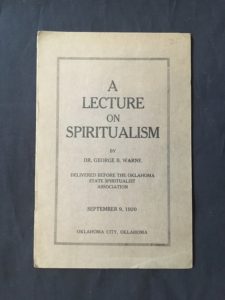 Delivered as part of a nationwide speaking tour, Warne frames Spiritualism in largely Christian terms, utilizing a great number of biblical quotes, but with a kind of casual irony reflective of the on-going conflicts between the two related religions. In answer to the question “Did God make man or did man make God?” Warne posits that they made each other.
Delivered as part of a nationwide speaking tour, Warne frames Spiritualism in largely Christian terms, utilizing a great number of biblical quotes, but with a kind of casual irony reflective of the on-going conflicts between the two related religions. In answer to the question “Did God make man or did man make God?” Warne posits that they made each other.
8vo, 9pp, staple bound pamphlet. Creasing to front wrap corners. Pages clean. Pasted, typewritten corrections on pg 4 and 7. Good condition.
$75

